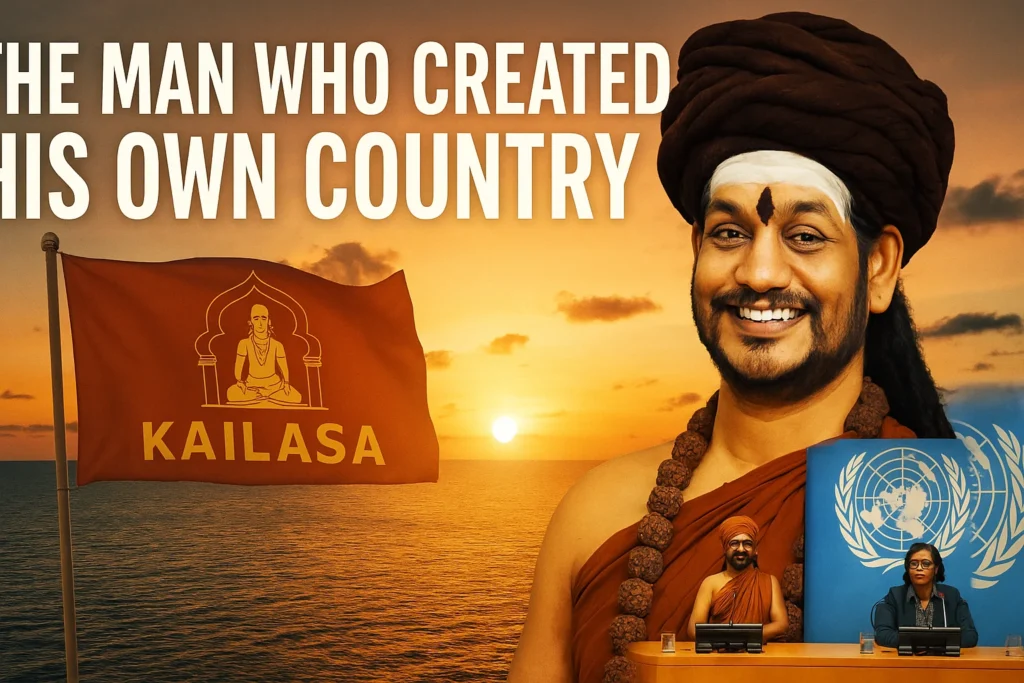Introduction: A Guru, a Fugitive, and a Floating Nation
In a world increasingly connected by digital threads, where information travels at light speed and audacious claims can go viral in an instant, one story stands out for its sheer audacity and mysterious allure. It’s the tale of a man who declared himself the head of his own country, a self-styled micro-nation known as “Kailasa.” This is not a quaint, quirky village with a funny name; it’s a venture born from the controversies surrounding a spiritual leader, a fugitive from justice, and an ambitious project that blends ancient spiritual ideals with modern-day marketing spectacle.
The man at the heart of this saga is Nithyananda, a self-proclaimed godman who once commanded a significant following in India. But his journey took a dramatic turn, leading him to flee the country and declare the birth of Kailasa. From claims of miraculous powers to surprising appearances on the global stage, Nithyananda and his elusive nation have kept the world guessing: Is Kailasa a genuine spiritual sanctuary, a clever marketing ploy, or simply an elaborate escape from legal troubles? Let’s unravel this curious modern mystery.
The Mastermind Behind Kailasa: Who is Nithyananda?
To understand Kailasa, we must first understand its founder. Nithyananda, born A. Rajasekaran in Tamil Nadu, India, rose to prominence as a spiritual guru with a significant following, establishing ashrams and centers both in India and abroad. He claimed to possess divine abilities, including the power to facilitate enlightenment and even delay sunrise. His teachings, a mix of Hinduism, Buddhism, and New Age spirituality, attracted many devotees seeking spiritual awakening.
From Guru to Fugitive
However, Nithyananda’s spiritual empire began to crumble under the weight of serious accusations. Starting in 2010, and escalating significantly by 2019, he faced a barrage of legal troubles in India. These allegations included:
- Rape and Sexual Assault: Multiple individuals came forward with accusations of sexual assault and rape.
- Child Abduction and Abuse: An FIR (First Information Report) was filed in Gujarat in 2019, accusing him and his associates of abducting and confining minors and a young woman at his ashram.
- Torture: There were also claims of torture within his ashram premises.
As the legal net tightened, Nithyananda, who had been granted bail in some cases, fled India in 2019. His bail was subsequently revoked in 2020 by the Karnataka High Court, officially making him a fugitive from Indian law. Despite his fugitive status, and even amidst rumors of his death in early April 2025 (which his organization vehemently denied, providing evidence of him alive and active in a live stream), Nithyananda has continued to operate, albeit from a distance, orchestrating the narrative of his new “nation.”
Kailasa: A Self-Proclaimed Hindu Nation
With the legal pressure mounting in India, Nithyananda made a bold announcement in 2019: he had founded his own country, the “United States of Kailasa” (USK), often simply referred to as Kailasa. This wasn’t just a spiritual retreat; it was presented as a sovereign state, complete with its own symbols and aspirations.
The Ideals of Kailasa
- A “Nation Without Borders”: Nithyananda proclaimed Kailasa as a “nation without borders,” created specifically for “dispossessed Hindus around the world who lost the right to practice Hinduism authentically in their own countries.” It claims to be a refuge for persecuted, aspiring, or practicing Hindus, offering a sanctuary for the revival of “authentic Hinduism.”
- Sovereign Claims: Kailasa asserts its status as the world’s only sovereign Hindu nation, dedicated to the “preservation, restoration and revival of an enlightened culture and civilization based on authentic Hinduism.”1 It claims to have its own constitution, although its contents and legality remain unclear and unrecognized globally.
- State-like Features: To bolster its claims of statehood, Kailasa purports to issue its own passports, currency (the “Kailashian dollar,” which Nithyananda showcased in August 2020, inspired by ancient Hindu currencies), and even a unique “Kailasa Visa Australia” program for potential visitors.
Essentially, Kailasa presents itself not just as a spiritual movement but as a fully functional, independent country, offering a haven and a way of life based on its founder’s interpretation of ancient Hindu principles. The ambitious nature of these claims immediately set it apart from typical spiritual organizations.
The Elusive Location: Where is Kailasa?
One of the most persistent and intriguing questions surrounding Nithyananda’s self-proclaimed nation is its actual physical location. Despite grand pronouncements, definitive proof of Kailasa’s whereabouts remains elusive, contributing to its mystique and skepticism.
The Mystery of the Island
- “Off the Coast of Ecuador”: When Nithyananda first announced Kailasa, reports, largely based on his own claims, stated that he had purchased a private island off the coast of Ecuador. This location, supposedly in the Andean region of South America, was chosen, according to Nithyananda, for the “immunity” it offered him as a head of state, making him “non-prosecutable.”
- Lack of Visual Confirmation: Despite these claims, verifiable photographic evidence or precise geographical coordinates of this island have never been publicly confirmed by independent sources. News organizations and investigative journalists have largely found it difficult to pinpoint its exact location or confirm the existence of any established infrastructure.
- A “Network of NGOs”: In absence of a clearly defined territory, Kailasa is also described as a “network of non-governmental organizations spanning three continents.” This broad definition allows its operations to exist in various places without being tied to a single, easily identifiable landmass.
- Recent Claims and Incidents: While the “Ecuador island” remains the most widely cited claim, recent incidents in 2025 have further complicated the picture. Kailasa representatives have been active in South America, attempting to secure land leases in Bolivia, which led to arrests and deportations, and signing dubious MOUs in Paraguay. These activities suggest attempts to establish a physical presence or influence, even if a centralized “capital” remains unconfirmed.
Ultimately, for most of the world, Kailasa exists more as a concept, a digital presence, and a series of grand claims rather than a recognized sovereign territory on any map. Its location remains as much a part of its marketing as it is a geographical reality.
The UN Photo-Op: Fact, Fiction, and International Embarrassment
Perhaps the most publicized incident involving Kailasa occurred in February 2023, when representatives of the self-proclaimed nation appeared at a United Nations meeting in Geneva. The event quickly turned into a global spectacle, sparking both amusement and concern.
A Seat at the Table?
- The Appearance: A woman identified as Vijayapriya Nithyananda, dressed in traditional attire and elaborate jewelry, claimed to be a representative of the “United States of Kailasa” and spoke at a UN Committee on Economic, Social and Cultural Rights (CESCR) discussion. She used the platform to allege “persecution” of Nithyananda and highlighted Kailasa’s supposed initiatives in “sustainable development,” claiming that basic necessities like food, shelter, and education were offered for free to its citizens.
- The Viral Moment: Photos and videos of Kailasa’s representatives at the UN circulated widely, giving the impression that the micro-nation had somehow gained recognition on the international stage. Nithyananda’s social media accounts amplified these images, fueling the narrative of Kailasa’s legitimacy.
- UN Clarification and Reaction: The United Nations was quick to clarify the situation. They stated that general discussions of their committees are often open to submissions from non-governmental organizations (NGOs) and stakeholders, and participation in such events does not imply any recognition of statehood or legitimacy. The incident was widely viewed as an embarrassment for the UN and a clear example of Kailasa’s shrewd propaganda tactics. No UN officials responded to Kailasa’s comments or questions during the session.
Despite the UN’s swift dismissal, Kailasa continues to leverage its involvement in such forums. Its website frequently highlights “reports” published by the UN, claiming they “reaffirm its juridical statehood” (e.g., the 22nd and 23rd reports cited in December 2024 and April 2025). This selective interpretation of events underscores Kailasa’s strategy: to present itself as a legitimate entity, regardless of formal international recognition.
Legal Labyrinth: Fugitive Status and Global Repercussions
Nithyananda’s escape from India and his subsequent declaration of Kailasa are inextricably linked to a complex web of legal challenges. His fugitive status in India means he is wanted for serious criminal charges, and his international endeavors with Kailasa have drawn scrutiny from legal authorities and governments worldwide.
The Law’s Long Arm
- Non-Bailable Warrants: In India, Nithyananda faces non-bailable warrants related to charges of rape, sexual assault, kidnapping, and child abuse. He fled the country to evade these proceedings, and his legal team has consistently denied all charges, often framing them as an “anti-Hindu conspiracy” or “persecution.”
- Lack of International Recognition: A fundamental legal hurdle for Kailasa is its lack of recognition as a sovereign state under international law. This means that any “passports,” “currencies,” or “visas” issued by Kailasa have no legal validity in the eyes of established nations or international organizations. This also means Nithyananda cannot claim diplomatic immunity as a head of state.
- International Incidents and Diplomatic Blunders: Kailasa’s attempts to establish itself on the global stage have led to several embarrassing diplomatic incidents:
- Paraguay (December 2023): A chief of staff in Paraguay’s Ministry of Agriculture was sacked after signing a Memorandum of Understanding (MoU) with Kailasa representatives, reportedly under the false impression that Kailasa could offer assistance in irrigation. The Paraguayan government quickly disavowed the agreement.
- Newark, USA (2023): The mayor of Newark, New Jersey, had to rescind a “sister cities” agreement with Kailasa days after holding a ceremony, following public backlash and media scrutiny.
- Bolivia (April 2025): Perhaps the most concrete legal entanglement occurred recently in Bolivia. Officials arrested 20 people associated with Kailasa, accusing them of “land trafficking.” These individuals had signed dubious 1,000-year leases with Indigenous groups in the Amazon for vast tracts of land. The agreements were declared void, and the Kailasa followers were deported to their actual home countries, including India, the US, Sweden, and China, rather than to the mythical Kailasa. This incident highlighted that Kailasa’s attempts at land acquisition were very real, even if its sovereignty was not.
These incidents demonstrate that while Kailasa operates in a grey area of spiritual claims and digital presence, its forays into the physical and political world are met with firm legal and diplomatic pushback from established nations.
Building a Virtual Kingdom: Marketing and Propaganda
Kailasa’s existence thrives not on traditional diplomatic recognition, but on an elaborate and sophisticated marketing and propaganda machine. From dedicated media channels to online citizenship programs, Nithyananda’s team has mastered the art of digital self-promotion to project an image of legitimacy and global influence.
The Digital Arsenal
- Multi-Platform Broadcasting: Kailasa operates its own extensive media network through its “Department of Information Broadcasting.” This includes dedicated channels like Nithyananda TV, Kailasa TV, and Hinduism Now TV, along with digital publications like the Nithyananda Times magazine. These platforms broadcast sermons, discourses, news, events, and “authentic Hindu content” in multiple languages to a global audience.
- Online Citizenship and Recruitment: Kailasa actively recruits followers and “citizens” through its official website, offering “e-citizenship.” This program is open to “all practicing and aspiring Hindus & all individuals with an interest in Hindu Religion, Culture, Heritage and Sciences.” E-citizens are promised benefits such as special spiritual services, “Darshans” (blessings) from Nithyananda, and access to exclusive spiritual materials.
- The “Kailasa Visa Australia” Program: To attract visitors to its proclaimed physical location, Kailasa has advertised a “Kailasa Visa Australia” program. This involves flying from Australia via a specially chartered flight service called “Garuda,” with promises of free food and accommodation on the island. This carefully constructed narrative aims to lend an air of exclusivity and reality to the elusive nation.
- Strategic Photo-Ops and Press Releases: As seen with the UN incident, Kailasa leverages any opportunity for public visibility. They strategically organize photo opportunities with politicians and officials worldwide, later disseminating these images widely to create the impression of diplomatic ties and global acceptance. Their press releases often frame any criticism as “malicious smear campaigns” or “disinformation” orchestrated against them, portraying Nithyananda and Kailasa as victims of persecution.
- Emphasis on “Humanitarian” Efforts: Kailasa’s propaganda also highlights its supposed humanitarian efforts, cultural preservation initiatives, and environmental protection projects, attempting to present itself as a benevolent and responsible global actor.
This extensive digital footprint allows Kailasa to maintain its narrative, reach potential followers, and project an image of a thriving, legitimate entity, despite its lack of formal recognition. It’s a testament to the power of modern media and online influence in shaping perceptions.
Global Reactions: From Mockery to Concern
The international community’s reaction to Kailasa has been a mixed bag, ranging from widespread mockery and skepticism to serious concern over Nithyananda’s fugitive status and the potential exploitation of followers.
A Quixotic Venture or a Real Threat?
- Lack of Recognition: Fundamentally, no sovereign nation or major international organization officially recognizes Kailasa as a legitimate country. Governments and international bodies view it as a self-proclaimed entity, or “micronation,” that lacks the necessary criteria for statehood under international law.
- Diplomatic Disavowals: The incidents in Newark, Paraguay, and Bolivia clearly illustrate the swift disavowal by established governments when Kailasa attempts to formalize its presence or influence. These nations have made it unequivocally clear that any interactions do not imply recognition of Kail micro-nation. The deportation of Kailasa associates from Bolivia in April 2025 further highlights this firm stance.
- Media Scrutiny: Major international news outlets have largely covered Kailasa with a critical and often bemused tone, highlighting its fictional nature and the controversies surrounding its founder. They often frame it as a bizarre, modern saga that intersects spirituality, law, and digital theatrics.
- Concerns for Followers: Beneath the spectacle, there are serious concerns from human rights organizations and legal experts regarding the safety and well-being of Nithyananda’s followers, particularly those who may reside in or visit Kailasa’s elusive locations. The allegations against Nithyananda include child abduction and abuse, which raise red flags about the environment within his self-styled nation.
- The “Micronation” Context: Kailasa is often categorized alongside other “micronations” like Sealand or Liberland. However, unlike many largely harmless, hobbyist micronations, Kailasa is distinct due to its founder’s fugitive status and the serious criminal allegations against him, which elevates the level of scrutiny and concern.
While Kailasa continues to project an image of global acceptance and influence, the overwhelming response from recognized international bodies and governments is one of non-recognition and, in cases of attempted legal or political interference, firm rejection.
Conclusion: Where Fact and Spectacle Collide
The saga of Nithyananda and Kailasa is a fascinating, perplexing, and at times, alarming modern story that perfectly illustrates the collision of spiritual aspiration, legal evasion, and the boundless possibilities of digital communication. What began as a charismatic guru’s following transformed into a desperate flight from justice, culminating in the audacious declaration of a new country.
Where is Kailasa? In a literal sense, it remains largely elusive, a land that appears to float between fleeting claims of an Ecuadorian island and various attempts to establish a physical presence in other parts of South America. But in another sense, Kailasa exists powerfully in the digital realm—a self-proclaimed nation built on an elaborate web of websites, social media channels, and carefully orchestrated propaganda.
The high-profile UN photo-op, the signing of dubious MOUs, and the recent arrests in Bolivia all serve as stark reminders that while Kailasa may exist in the realm of spectacle and marketing, its attempts to interact with the real world are met with the harsh realities of international law and diplomacy. As long as Nithyananda remains a fugitive wanted for serious crimes, Kailasa will continue to be viewed by the world as a curious, if concerning, venture—a testament to how charisma, controversy, and digital platforms can be leveraged to create a self-styled micro-nation that thrives between myth and undeniable marketing.



